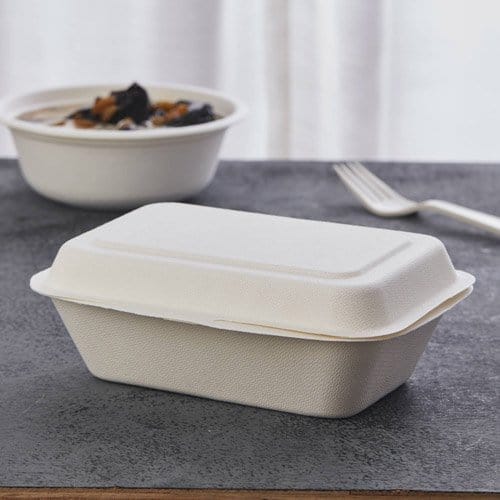Introduction
As environmental consciousness accelerates globally, the need for sustainable alternatives to traditional plastic packaging becomes more urgent.
Biodegradable food containers are stepping into the spotlight as a transformative force, offering eco-friendly solutions without compromising convenience or performance.
In 2025, the biodegradable packaging sector is booming—driven by government regulations, consumer demands, and rapid technological innovation.
This article explores eight compelling reasons why biodegradable food containers are no longer a niche choice, but the future of the food packaging industry.

1. They Drastically Reduce Plastic Pollution
Each year, more than 8 million tons of plastic end up in our oceans, disrupting ecosystems and harming marine life.
Conventional plastic containers, which can take up to 500 years to decompose, are a major contributor.
Biodegradable food containers, made from materials like bagasse, cornstarch, and PLA (polylactic acid), break down within 90–180 days in composting conditions.
Switching to these eco-friendly alternatives helps curb the overwhelming tide of plastic waste, protecting marine biodiversity and promoting healthier ecosystems.
2. They Lower Carbon Footprint Across the Lifecycle
A 2024 Life Cycle Assessment study revealed that plant-based packaging like biodegradable food containers can reduce greenhouse gas emissions by up to 70% compared to petroleum-based plastics.
From raw material sourcing to manufacturing and end-of-life disposal, the carbon footprint of biodegradable containers is significantly smaller.
Brands adopting these solutions contribute meaningfully to global climate action targets, such as achieving Net Zero Emissions by 2050.
3. They Are Made from Renewable Resources
Unlike plastics derived from fossil fuels, biodegradable food containers are produced from rapidly renewable resources like:
-
Sugarcane fibers (bagasse)
-
Corn starch
-
Cassava roots
-
Bamboo pulp
These resources grow quickly, require fewer chemical fertilizers, and support sustainable agricultural practices.
By shifting toward plant-based packaging solutions, the packaging industry reduces dependency on finite natural resources and supports rural economies.
4. They Strengthen Brand Loyalty Among Eco-Conscious Consumers
According to a NielsenIQ report, 73% of global consumers are willing to change consumption habits to reduce environmental impact.
Brands offering sustainable food packaging solutions, like biodegradable takeout containers, are perceived as more trustworthy, responsible, and forward-thinking.
Restaurants, grocery stores, and meal delivery services adopting eco-friendly food containers report increased customer loyalty, positive brand sentiment, and stronger long-term engagement.
5. They Support Circular Economy Principles
The circular economy model emphasizes designing out waste, keeping products in use longer, and regenerating natural systems.
Compostable food containers fit seamlessly into this model:
-
After use, containers are composted into nutrient-rich soil amendments.
-
Composting returns valuable organic matter to the earth, closing the resource loop.
-
The result is a regenerative system that contrasts sharply with the "take-make-dispose" pattern of traditional plastic packaging.
Choosing biodegradable packaging transforms businesses from part of the waste problem into part of the solution.
6. They Meet Growing Regulatory Requirements Worldwide
Governments worldwide are increasingly regulating single-use plastics.
For example:
-
The EU Single-Use Plastics Directive bans many disposable plastic items.
-
In the U.S., states like California, Maine, and New York mandate compostable alternatives in foodservice.
-
Asian nations like India and China have introduced broad restrictions on plastic packaging.
Biodegradable food containers allow businesses to stay ahead of regulatory curves, avoiding fines, reputational damage, and last-minute operational disruptions.
7. They Enable Innovation in Food Packaging Design
Biodegradable materials are surprisingly versatile:
-
Bagasse tableware are grease-resistant and microwave-safe.
-
PLA clamshells offer high transparency for cold food presentation.
-
Cornstarch-based trays are sturdy enough for both hot and cold dishes.
-
Compostable paper bowls can even be coated with water-based linings, eliminating petroleum plastics entirely.
Brands can customize shapes, textures, and branding designs while maintaining environmental integrity—offering a powerful blend of creativity and responsibility.
8. They Contribute to Healthier Living Environments
Unlike traditional plastics that can leach harmful chemicals (e.g., BPA, phthalates) into food, biodegradable food containers are non-toxic and food-safe.
Industrial composting of biodegradable containers also reduces landfill methane emissions—a potent greenhouse gas.
Thus, adopting biodegradable packaging not only benefits the global environment but also supports healthier homes, workplaces, and communities.
Real-World Case Study: The Bioleaderpack Impact
A leading Chinese manufacturer, Bioleaderpack, has successfully replaced 80% of its foodservice product lines with biodegradable options, including bagasse clamshells, compostable bowls, and biodegradable food containers for takeout.
Through collaborations with major international restaurant chains, Bioleaderpack helped reduce single-use plastic consumption by over 1,200 tons annually.
Their work demonstrates how manufacturers can drive industry-wide change through innovation and commitment to sustainability.
Conclusion
In 2025, biodegradable food containers are no longer optional—they are essential.
From reducing carbon emissions to meeting consumer expectations and regulatory demands, these containers offer a future where packaging doesn't harm the planet but restores it.
Businesses that embrace sustainable food packaging today will be the leaders of tomorrow's green economy.
The transition is happening now. Will you be part of it?






